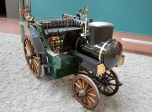Cars from 1878 to 1920 - The forerunners
Peugeot BB
1913
Code 1409
Body style: torpedo
In 1910, Ettore Bugatti had just started production in Molsheim but was struggling for money. He turned to the big car-builders of the time, offering a licence to manufacture a small, efficient automobile for a broad market. The project was eventually taken on by Peugeot. The Peugeot-style radiator is noticeable, in place of the classic Bugatti horse-shoe shape. However, the rest of this cute two-seater – its body and mechanical components – is faithful to the Bugatti design.
The “BB”, which takes its name from its small size (sounds like ‘baby’), was a real commercial success, with Peugeot producing more than 3,000 units and selling them right across the world. Another “BB” in our collections (Code 1408) was sold to Tianjin in China!
BBs were used as lightweight liaison vehicles during the Great War. Production came to an end in 1916, but the royalties paid to Bugatti by Peugeot made a significant contribution to improving facilities at the Bugatti plant in Molsheim.
This car originally had a two-speed gearbox and a 855 cc, 11 horsepower engine, and could carry two adults at speeds of 60 kph (40 mph). From 1913, it gained a three-speed gearbox, which made the car even more pleasurable to drive.
This example, Code 1409, dates back to 1913, a big year for the BB. Some of the 1913 chassis were driven by the leading racing drivers, such as French champion Georges Boillot, Peugeot’s ace racer, who achieved some amazing performances.
3,095 of these cars were built at the Lion plant in Beaulieu, Eastern France from late 1912 to 1916. There are still a surprising number of Peugeot BBs in existence to this day. The Cité de l’Automobile has an outstanding selection of BB2s and BB3s.



















